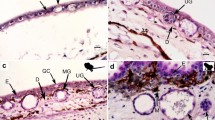Abstract
Behavior observations in European reindeer (Rangifer tarandus) showed a high frequency of sniffing the tails of conspecifics. A caudal gland was found, and it is the largest skin gland inRangifer. Behavioral contexts of tail sniffing, the histology of the gland, and some aspects of the composition of the volatiles in the gland's secretion are described.
Similar content being viewed by others
References
Andersson, G., Andersson, K., Brundin, A., Rappe, C. 1975. Volatile compounds from the tarsal scent gland of reindeer (Rangifer tarandus).J. Chem. Ecol. 1:275–281.
Brundin, A.,Andersson, G.,Andersson, K.,Mossing, T.,KÄllquist, M.-L. 1977. Short aliphatic acids in the interdigital gland of the reindeer(Rangifer tarandus L.) and their discrimination by reindeer.J. Chem. Ecol. in press.
Espmark, Y. 1971. Mother-young relationship and ontogeny of behavior in reindeer(Rangifer tarandus L.).Z. Tierpsychol. 29:42–81.
Glenn, E.M., andGray, J. 1965. Effect of various hormones on the growth and histology of the gerbil(Meriones unguiculatus) abdominal sebaceous gland pad.Endocrinology 76:1115–1123.
Lewin, V., andStelfox, J.G. 1967. Functional anatomy of the tail gland and associated behavior in woodland caribou.Can. Field Nat. 81:63–66.
Moy, R.F. 1970. Histology of the subauricular and rump glands of the pronghorn(Antilocapra americana Ord.)Am. J. Anat. 129:65–88.
Müller-Schwarze, D. 1971. Pheromones in black-tailed deer.Anim. Behav. 19:141–152.
Müller-Schwarze, D. 1977. Complex mammalian behavior and pheromone bioassay in the fieldin D. Müller-Schwarze and M.M. Mozell (eds.) Chemical Signals in Vertebrates. Plenum Press, New York, pp. 413–433.
Müller-Schwarze, D., Volkman, N.J., andZemanek, K.F. 1977a. Osmetrichia: Specialized scent hair in black-tailed deer.J. Ultrastruc. Res. 59:223–230.
Müller-Schwarze, D.,KÄllquist, L. andMossing, T. 1977b. Social behavior and chemical communication in reindeer,Rangifer tarandus L. In preparation.
Quay, W.B. 1955. Histology and cytochemistry of skin gland areas in the caribou,Rangifer.J. Mammal. 36:187–201.
Quay, W.B., andMüller-Schwarze, D. 1970. Functional histology of integumentary glandular regions in black-tailed deer(Odocoileus hemionus columbianus).J. Mammal. 51:675–694.
Tschanz, B. 1962. Über die Beziehungen zwischen Muttertier und Jungen beim Mufflon.Experientia 18:187–190.
Author information
Authors and Affiliations
Rights and permissions
About this article
Cite this article
Müller-Schwarze, D., Quay, W.B. & Brundin, A. The caudal gland in reindeer (Rangifer tarandus L.): Its behavioral role, histology, and chemistry. J Chem Ecol 3, 591–601 (1977). https://doi.org/10.1007/BF00989079
Received:
Revised:
Issue Date:
DOI: https://doi.org/10.1007/BF00989079




